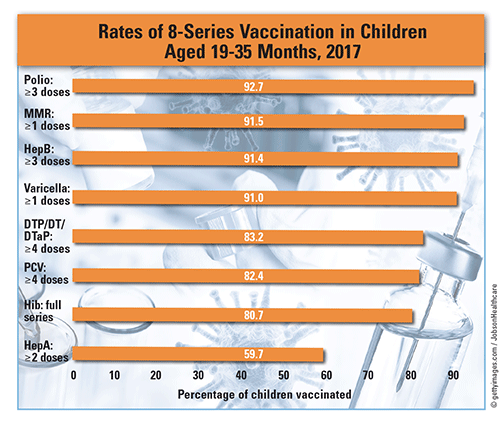US Pharm. 2021;46(4):14.

According to the CDC, approximately 4 million babies are born each year in the United States. Healthy People 2030 has set a target of reducing the rate of infant deaths from 5.8 to 5 per 1,000 live births. The Advisory Committee on Immunization Practices recommends routine vaccinations including varicella; diphtheria, tetanus, pertussis (DTaP); measles, mumps, rubella (MMR); hepatitis A (HepA); and hepatitis B (HepB), among others, by age 24 months. Between 2010 and 2017, vaccination rates increased across all ethnicities. Despite this increase, between 16% and 20% fewer babies below the federal poverty level were vaccinated compared with their above-poverty-level peers, with the greatest difference for black children (20%). In 2017, below-poverty-level white, black, and Hispanic babies had vaccination increases of 31.42%, 15.54%, and 12.36%, respectively, over 2010.
MMR: In the 21st century, the number of babies not receiving MMR vaccination by age 2 years has contributed to outbreaks of measles and mumps. In 2019, 1,282 cases of measles were confirmed (vs. 667 in 2014), the greatest number reported since 1992. The rate of MMR vaccination in babies between 2010 and 2017 has not changed; however, there are disparities across ethnic groups. Increased MMR vaccination was reported among babies who were Asian, of two or more races, or white (by 3.71%, 2.34%, and 0.66%, respectively), whereas Hispanic, black, and Native American babies had fewer vaccinations (by 0.75%, 2.82%, and 4.18%, respectively) during the same period.
DTaP: There have been outbreaks of pertussis related to nonvaccination. Among the CDC’s objectives is to increase the coverage level of four doses of DTaP vaccine by age 2 years. Between 2010 and 2017, the vaccination rate fell from 84.4% to 83.2% (a drop of 1.2%). However, the drop was not consistent across all ethnic groups. Although the rate of DTaP vaccination increased by 0.36%, 0.91%, and 1.81% among Hispanic, Asian, and white babies, respectively, the rate decreased by 1.33%, 4.78%, and 9.05% among babies of two or more ethnicities, black babies, and Native American babies, respectively.
HepA and HepB: Between 2010 and 2017, the number of infants who were vaccinated for HepA and for HepB were at two ends of a continuum. For HepA, the vaccination rate increased by 20.12%, whereas HepB had a 0.44% drop in vaccination rate. However, this pattern was not consistent across ethnicities. Among babies who received the HepB vaccine, Asian babies and those of two or more ethnicities had a nominal increase in vaccination of 3.27% and 1.33%, respectively. The increase in HepA vaccination rates across different ethnicities ranged from 11.11% to 35.63%.
The content contained in this article is for informational purposes only. The content is not intended to be a substitute for professional advice. Reliance on any information provided in this article is solely at your own risk.
To comment on this article, contact rdavidson@uspharmacist.com.





